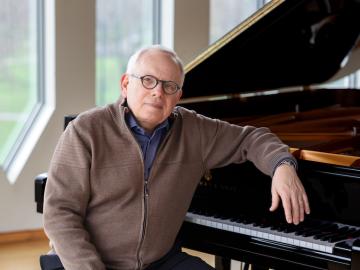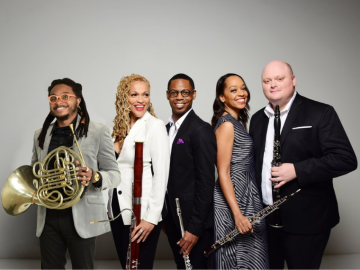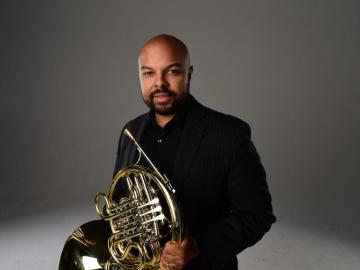Art from the North Coast to the West Coast
December 7, 2017
Hillary Hempstead

Associate Professor of Integrated Media Art Julia Christensen explores the ecoregion of Lake Erie to the technology scene in Los Angeles.
From Cleveland to Los Angeles, Julia Christensen is captivating the art world with her use of technology to explore large concepts and systems.
Christensen has been operating at full-throttle since 2008 when she garnered attention with Big Box Reuse, a book that examines how communities reuse abandoned big box buildings. A subsequent project titled “Surplus Rising” explored the repurposing of industrial equipment salvaged from defunct factories. A more recent pursuit, funded by a Creative Capital grant, took her to India and China to scavenge for discarded electronic waste from which she built video projectors. Further iterations of this ongoing project about upgrade culture and electronic waste have included photographs, drawings, installations, and writing.
Christensen’s work explores systems, typically those of technology, consumerism, landscape, and memory. She admits to being fueled by large concepts that often span disciplines, and she has a history of employing video and photography in her installations.
So it’s not so surprising that her three newest projects, each supported by grants, were all born of a deep interest in and questions about large systems—in this case, two very different ones: the ecoregion of Lake Erie and a museum in Los Angeles.
Examining Water Systems in Lake Erie
Waves crash against the hull of the ferry that Christensen takes from Port Clinton, Ohio, to South Bass Island. During the summer, the boat that shuttles fun-seekers to and from the island bustles, but in November the ferry is relatively quiet, save the rough water splashing on the deck.
It is on this island that Christensen meets her partners from Stone Lab, a research center operated by the Ohio Sea Grant, who have been assisting with video camera placement on Gibraltar Island, a small swath of land just off South Bass Island. Here, Christensen works to realize her vision for Waiting for a Break, a public art piece commissioned by LAND Studio, supported by the Char and Chuck Fowler Foundation and the Group Plan Commission.
Christensen’s inspiration for the project was twofold: Oberlin’s proximity to Lake Erie and her simple curiosity about what happens to the lake during the offseason. “Living in Oberlin, we’re just a few miles from the lake. I wanted to think about it in ways I don’t usually. I thought—what happens on the lake in the middle of the winter? What would I see? And how could I see it?”
So she devised a plan to broadcast, for six months, live video feeds of the lake, from mid-December through June 2018. To do this, she has positioned six cameras on South Bass and Gibraltar Islands. Two other cameras are situated further west on Lake Erie’s Western Basin at the University of Toledo’s Lake Erie Center on the Maumee Bay.
Waiting for a Break: A Project By Julia Christensen
In downtown Cleveland, a large outdoor kiosk on Public Square has been created to display live feeds from Lake Erie’s shores, as the lake's ice forms, shifts, and eventually breaks. Christensen hopes those who travel through Public Square can develop a relationship with the kiosk, which serves as the public art component of the piece. “Public Square is a pedestrian area where people get on buses and walk between businesses—people can see the kiosk every day. In the beginning they might think, ‘What is this? What am I looking at?’ But as the water changes, they can develop a relationship with what’s happening on the lake.”
Christensen believes this piece will bring awareness to the lake’s ecosystem. “When we think about icebergs melting, it’s hard to conceptualize. But we have one of the largest fresh water reserves here, and it freezes as well. Broadcasting these video feeds is a way to show the public that climate issues also exist in our backyard. And considering that climate change is causing the Great Lakes' ice coverage to become increasingly erratic, it is a perfect time to remember that ice is a good thing.”
Not far from the display on Public Square, Christensen is creating a second installation at SPACES, a contemporary art venue on Cleveland’s near west side. With support from the SPACES R&D program, she will create the Waiting for a Break gallery show. The exhibition opening January 26, 2018, will serve as an immersive representation of the kiosk on Public Square and includes access to all eight video feeds of Lake Erie, time lapse animations of the feeds, photographs, maps, and scientific research materials. The feeds will also be visible to passersby, as the gallery will feature the live feeds in its front window beginning on December 16.
“Now more than ever, we need to build a platform for dialog around the health of our Great Lakes,” says Christensen. “Because as we know, the Great Lakes have been waiting for a break for a long time.”
Exploring Technology Systems in Los Angeles
More than 2,000 miles west of Cleveland and Lake Erie is Los Angeles, the site of Christensen’s third project.
From a pool of more than 700 applicants, Christensen was one of four artists awarded a fellowship at the Los Angeles County Museum of Art (LACMA) Art + Technology Lab, a program that supports artist experiments with emerging technology.
There, she has been matched with professionals from major corporations including Google, Hyundai, SpaceX, Accenture, and NASA’s Jet Propulsion Lab to explore the intersection of art and technology. The award also comes with a $50,000 grant, access to space and resources at LACMA, and her research will culminate in a premiere at LACMA during the fall of 2018. The artwork she is making at LACMA is the latest extension of her Creative Capital-supported project about contemporary upgrade culture.
Christensen, whose work often explores how society recontextualizes what it discards, is in the conceptual stage for two art pieces in her fellowship. Through an installation titled Upgrade Available, she aims to emphasize the “futility and anxiety of upgrade culture” by upgrading and downgrading pieces in the museum’s institutional archives into “an absurd lineage of technologies.”
Her second piece is a site-specific installation that draws attention to obsolete technology throughout LACMA, such as the ports once used for telephones, coaxial connectivity, and even robots. “A robot called the Cybermotion SR2 was used in the early 1990’s to assist the LACMA security team,” says Christensen. “The robot did not last long at LACMA, for various reasons, but once the infrastructure was put in place, it was difficult to remove, so ports still stand throughout the galleries.”

Christensen drew significant inspiration for this project from her collaboration with SpaceX, a designer, manufacturer, and launcher of rockets and spacecraft, founded by Elon Musk. She is in ongoing conversations with the company to imagine future museum architecture in the context of the modular, reusable systems that SpaceX is designing for space travel.
Christensen explains that the installation will also ask how museum buildings can possibly be designed to keep pace with the contemporary rate of technological innovation. And because LACMA is about to undergo a building redesign, Christensen says that “it is a particularly a good time to ask these questions.”
Tags:
You may also like…
Peter Takács—A Half-Century Celebrated
May 4, 2024
This spring marks the official conclusion of Takács’ tenure, after an incredible 48 years of teaching. Many of his former students from around the world are set to convene for a celebratory concert in Warner Concert Hall on May 12
Oberlin Presents Grammy-Winning Imani Winds in Concert
February 28, 2024
When flutist Brandon Patrick George ’08 attended Imani Winds’ Artist Recital Series performance back in 2007, he never imagined that he would one day sit in the flute chair. “Being...
David Byrd-Marrow Appointed Horn Faculty at Oberlin Conservatory
February 7, 2024
Versatile American horn player David Byrd-Marrow has been appointed to the tenure-track horn professor position at Oberlin Conservatory. He brings an expansive range of experience and repertoire to the role.


